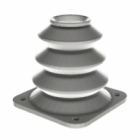Sustainable 3D printing materials
As 3D printing matures from prototyping novelty to mainstream production tool, sustainability has become a defining factor in material development. It’s no longer just about speed, customization, or part performance — manufacturers, designers, and even hobbyists are increasingly asking: How sustainable is what we print?
While many additive manufacturing technologies are inherently efficient — producing less waste than subtractive methods — it’s the materials themselves that shape the true environmental footprint of 3D printing. From bio-based resins to recycled filaments and reclaimable powders, sustainable materials are at the core of a more responsible digital manufacturing workflow.
What makes a material “sustainable” in additive manufacturing?
There’s no universal checklist for what counts as “green” in 3D printing, but sustainable materials typically meet several of these criteria:
- bio-based origin – derived from renewable sources like corn starch, castor oil, or algae,
- recyclability – can be reused mechanically or chemically with minimal property degradation,
- compostability – breaks down under industrial or natural conditions into non-toxic components,
- low processing impact – requires minimal energy or hazardous byproducts to print and post-process,
- transparent sourcing – traceable supply chains with minimal environmental exploitation.
The more boxes a material ticks, the stronger its sustainability credentials. But not every “eco” label is backed by data — so transparency, third-party certifications, and life cycle analysis (LCA) are becoming essential.
Bio-based and recycled material options
Several materials already stand out in the market for their environmental performance. These include both plant-derived options and formulations made from recycled or reclaimed plastics.
PLA (Polylactic Acid)
The most common bio-based material in desktop FDM printing, derived from corn or sugarcane. Easy to print, low emissions, and biodegradable under industrial conditions. However, limited durability and thermal resistance restrict its applications.
PET and PETG with recycled content
Recycled PET, including ocean plastics, is increasingly being reformulated for filament use. PETG blends with post-consumer content offer better mechanical properties than PLA while reducing virgin plastic consumption.
Recycled PA12 (for SLS)
Powder-based nylon used in SLS printing can be partially reclaimed and reused in future builds. Some vendors now offer certified recycled nylon powders, supporting circular production workflows in industrial settings.
Bio-composites (wood, hemp, algae)
Filaments filled with organic particles — such as wood flour or hemp fibers — reduce the overall polymer content and add a tactile finish. These composites may not always be biodegradable, but they reduce reliance on petrochemicals.
Resins with bio-derived monomers
In SLA and DLP technologies, some manufacturers have begun offering plant-based or soy-derived resins. While less common, these options support sustainability goals in high-detail printing.
Comparing materials
| Material | Bio-based | Recyclable | Biodegradable | Processing energy | Post-processing impact |
|---|---|---|---|---|---|
| PLA | ✔️ | ♻️ (limited) | ✔️ (industrial) | 🔋 low | ⚠️ moderate (paints/coatings) |
| Recycled PETG | ✖️ (petro) | ✔️ | ✖️ | 🔋 medium | ✅ low |
| Recycled PA12 (SLS) | ✖️ | ♻️ (powder reuse) | ✖️ | 🔋 high | ✅ low |
| Wood / hemp composite | ⚠️ partial | ✔️ | ⚠️ depends on base polymer | 🔋 low / medium | ⚠️ moderate |
| Bio-derived resin | ✔️ | ✖️ | ✖️ | 🔋 medium / high | ⚠️ needs curing solvents |
| ABS (for contrast) | ✖️ | ✖️ | ✖️ | 🔋 medium | ⚠️ fumes, high post-impact |
Performance trade-offs
Eco-friendliness doesn’t always mean performance compromise — but trade-offs do exist. Sustainable materials may have lower heat resistance, reduced tensile strength, or greater moisture sensitivity. Bioplastics like PLA aren’t suitable for high-load environments, while some recycled filaments may have slight inconsistencies if quality control is lacking.
Moreover, post-processing can work against sustainability goals. Painting, sanding, or coating a biodegradable part with conventional chemicals may prevent it from breaking down as intended. For true sustainability, the entire lifecycle — including finishing and disposal — should be considered.
Circular models and in-process reuse
In powder-based technologies such as SLS or MJF, circularity is already becoming a reality. Unused powder from one job can often be sieved, refreshed, and reused in future builds — significantly reducing waste and cost per part. The key lies in powder refresh rates and proper storage to avoid degradation.
Some companies are also experimenting with closed-loop filament systems, where failed prints, support structures, or even end-of-life parts are ground down and re-extruded into fresh material. These systems hold promise but are currently more accessible to industrial users than individuals.
The future of sustainable 3D printing
Material innovation is moving fast. Research is underway into algae-based polymers, biodegradable engineering filaments, and fully compostable composite blends. More manufacturers are committing to transparency, publishing life cycle analyses (LCAs) and environmental product declarations (EPDs) to quantify their footprint.
For companies aiming to reduce their environmental impact, sustainable 3D printing materials are no longer niche — they’re becoming a competitive advantage. By adopting smarter material strategies today, you’re not only reducing waste and emissions — you’re building a production workflow designed to last.
Final thought
Sustainable 3D printing materials are reshaping what’s possible in additive manufacturing. They empower users to align their innovation with environmental responsibility — without always sacrificing performance. Whether you’re printing concept models or end-use parts, choosing the right material is about more than functionality — it’s a step toward a cleaner, more circular future.
Explore also
- Is 3D printing sustainable?
- 3D printing waste
- Is 3D printing bad for the environment?
- 3D print recycling
- 3D printing environmental impact
Related categories













